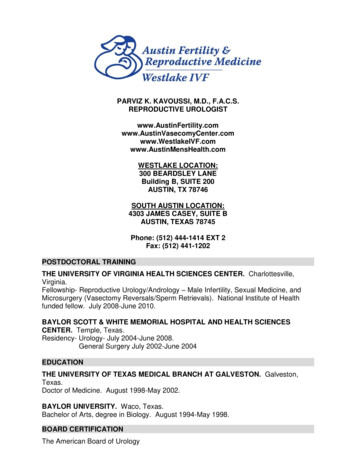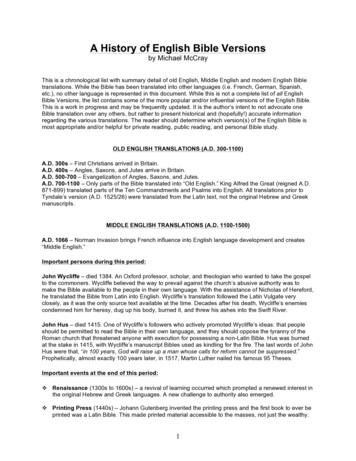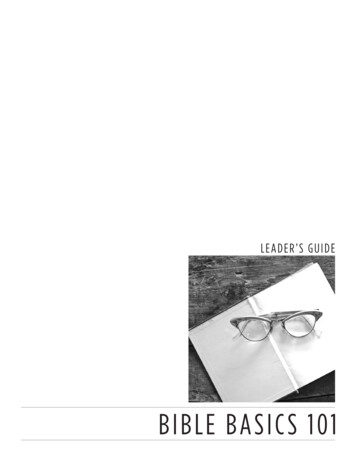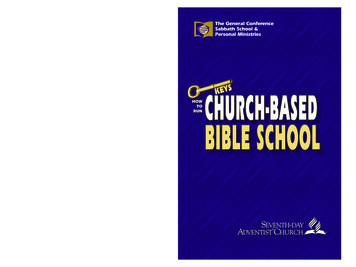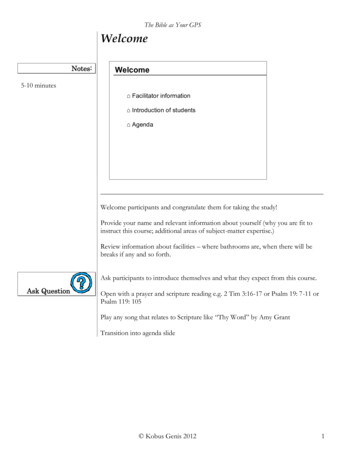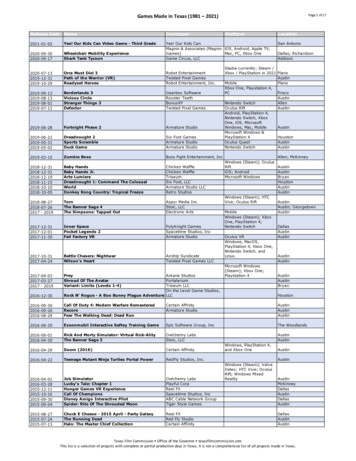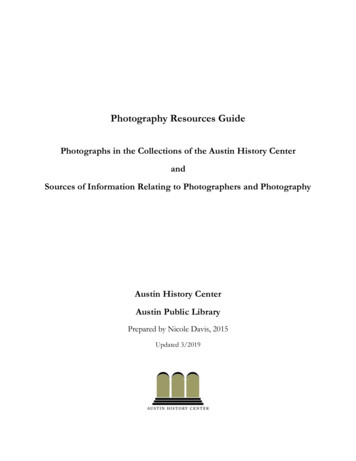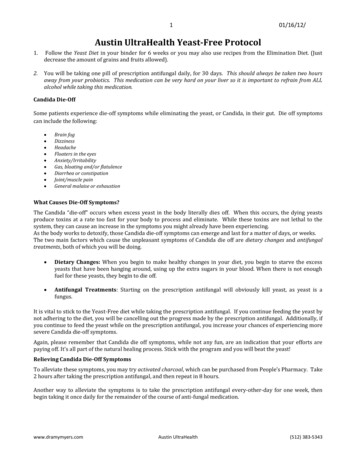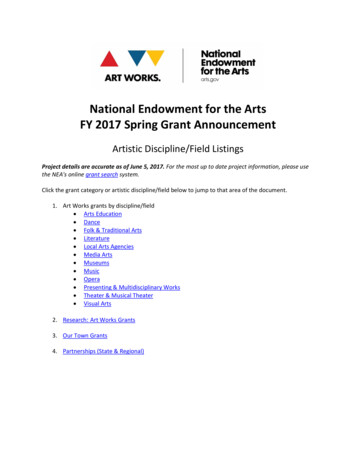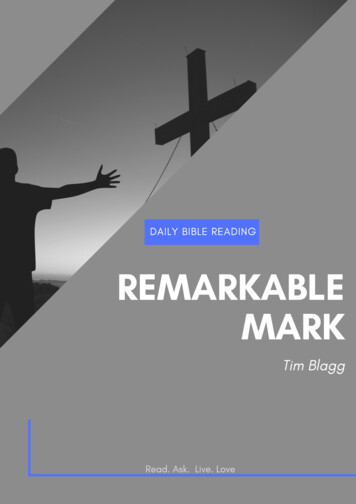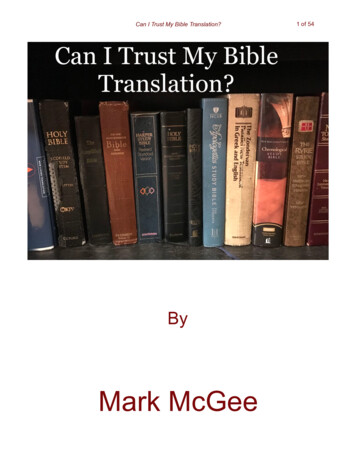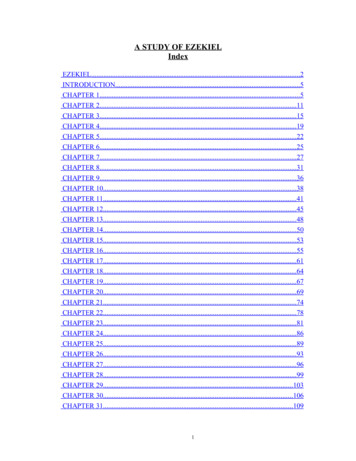
Transcription
EZEKIEL יְ ֶחזְ ֵקאל A chapter-by-chapter study guide, as taught by PastorRobert L. Bolender, at Austin Bible Church, 2000-2001.
EzekielIntroduction1Authorship and Date. The author of this book is “Ezekiel the priest, the son of Buzi” (1:3). Thename Ezekiel means “God will strengthen” or “God will harden.”1. Like Jeremiah (Jer. 1:1) and Zechariah (Zech. 1:1; cf. Neh. 12:4, 16), Ezekiel was a priest (Ezek. 1:3).Ezekiel’s father Buzi is mentioned only in 1:3. Jeremiah, Zechariah, and Ezekiel were the onlyprophet-priests; and all three prophesied during the exilic or postexilic periods. Ezekiel’spriestly background explains in part his emphasis on the temple in Jerusalem, the glory of theLord, the actions of Jerusalem’s priests, and God’s future temple.2. The date for Ezekiel’s ministry can be determined by noting the chronological notations in hisbook (1:2; 8:1; 20:1; 24:1; 29:1, 17; 30:20; 31:1; 32:1, 17; 33:21; 40:1).3. All Ezekiel’s prophecies are arranged chronologically (starting with “the 5th year of the exile,”1:2, and ending with “the 25th year of our exile,” 40:1, except the prophecies introduced in29:1,17). These two variations may be explained by the fact that they are grouped topically aspart of the prophecies against Egypt in chapters 29-32.4. Ezekiel’s ministry began “in the fourth month on the fifth day” of “the fifth year of the exile ofKing Jehoiachin” (1:1-2). Jehoiachin came to the throne in December 597 BC after Jehoiakimdied (2nd Kings 24:1-12). After a reign of only three months Jehoiachin was captured byNebuchadnezzar and deported to Babylon. The fifth year of Jehoiachin’s exile was 593 BC, andthe fourth month was the month Tammuz. According to Richard A. Parker and Waldo H.Dubberstein (Babylonian Chronology: 626 B.C.-A.D. 75. Providence, R.I.: Brown UniversityPress, 1956) the month Tammuz (Akk., Duzu) began on July 27 in 593 BC Therefore Ezekielbegan his ministry on July 31, 593 BC (the “fifth day” is inclusive, counting both July 27 and31).5. Ezekiel also said his ministry began “in the 30th year” (Ezek. 1:1). Scholars debate the exactmeaning of this statement, but many feel it refers to Ezekiel’s age. If so, he was commissionedas a prophet at the age he was qualified to enter the priesthood (cf. Num. 4:3).6. The last dated prophecy in Ezekiel was “in the 27th year, in the first month on the first day”(Ezek. 29:17). Since Ezekiel began prophesying in 593 (the fifth year of Jehoiachin’s exile, 1:2),this prophecy was 571 BC (March 26). So Ezekiel’s prophetic activity spanned at least 22 years(593-571 B.C.), from age 30 to 52.1Taken from: Walvoord, J. F., Zuck, R. B., & Dallas Theological Seminary. (1983-c1985). The Bible knowledgecommentary : An exposition of the scriptures. Wheaton, IL: Victor Books.Austin Bible ChurchPastor Bob Bolender1
Structure and Style. The structure and style of Ezekiel’s book has at least four majorcharacteristics.1. Chronological arrangement. As noted earlier under “Authorship and Date” a definitechronological movement is evident within the book. Ezekiel is the only major prophet withsuch a precise chronological arrangement but the Books of Haggai and Zechariah have asimilar arrangement.2. Structural balance. In addition to its chronological arrangement Ezekiel’s book also has astructural order and harmony.a. The first 24 chapters focus on the judgment of Judah; chapters 33-48 focus on therestoration of Judah.b. These two extremes are balanced by chapters 25-32 which deal with God’s judgment onother nations.c. The glory of God departed from the temple in judgment (9:3; 10:4, 18-19; 11:22-25) andreappeared in the temple for blessing (43:1-5).d. Ezekiel was commissioned to deliver a message of judgment (chaps. 2-3) and later wasrecommissioned to give a message of deliverance (chap. 33).3. Focus on the glory and character of God. Ezekiel emphasized the glory and character of God.a. Having received a vision of God’s glory before he was commissioned, Ezekiel continued torefer to God’s glory throughout the book (1:28; 3:12, 23; 8:4; 9:3; 10:4, 18-19; 11:22-23; 39:11, 21;43:2-5; 44:4).b. God’s character determined His conduct throughout the book.1) Fifteen times God declared that He had acted for the sake of His name to keep it frombeing profaned (20:9, 14, 22, 39, 44; 36:20-23 [twice in v. 23]; 39:7 [twice], 25; 43:7-8).2) Over 60 times God said He had acted so that the people would ”know that I am theLORD“ (e.g., 6:7, 10, 13-14).4. Use of literary devices. Ezekiel used unique literary devices to drive home his message to a“hardened and obstinate” people. By these means Ezekiel presented his messages in dramaticand forceful ways, thus getting the people’s attention so they would respond. These literarydevices included:a. proverbs (12:22-23; 16:44; 18:2-3);b. visions (chaps. 1-3; 8-11; 37; 40-48);c. parables (chap. 17; 24:1-14);d. symbolic acts (chaps. 4-5; 12; 24:15-27); ande. allegories (chaps. 16-17).Austin Bible ChurchPastor Bob Bolender2
Historical Background. (Background of Jeremiah, useful for Daniel & Ezekiel as well).Jeremiah’s ministry spanned the final five decades of Judah’s history. His call to service came in 627 B.C. inthe 13th year of King Josiah (cf. 1:2), Judah’s last good king. Josiah’s reign was the final ray of light before thedarkness of idolatry and foreign intrigue settled over the Davidic throne. Josiah came to the throne when he waseight years old, and provided 31 years of relative stability for Judah.Internally the nation of Judah was gripped by the idolatry that King Manasseh had promoted during his 55year reign (2 Kings 21:1-9). In 622 B.C. (Josiah’s 18th year) Judah experienced her final spiritual renewal (cf. 2Kings 22:3-23:25). Prompted by the rediscovery of a copy of the Mosaic Law in the temple, Josiah embarkedon a diligent effort to rid the nation of idolatry. He succeeded in removing the outward forms, but his efforts didnot reach into his subjects’ hearts. After Josiah’s untimely death, the people returned to their wicked ways.Internationally the Assyrian Empire, which had dominated the ancient Near East for centuries, was on thebrink of collapse. The capital city, Nineveh, had been destroyed in 612 B.C., and in 609 the retreating Assyrianarmy was defeated at Haran. The beleaguered remains of the once-great Assyrian Empire staggered toCarchemish just across the Euphrates River (see the map ”The World of Jeremiah and Ezekiel“).This collapse of Assyria was caused largely by the rise of another power-Babylon. In October 626 theChaldean prince Nabopolassar had defeated the Assyrian army outside Babylon and claimed the throne inBabylon. The kingdom he founded came to be known as the Neo-Babylonian Empire. He consolidated hisempire, and by 616 he was on the march to expand his territory. The combined army of the Babylonians andMedes destroyed Nineveh in 612.Babylon’s rise and Assyria’s collapse created a realignment of power throughout the area. Judah, underJosiah, threw off the yoke of Assyrian dominion and enjoyed a brief period of national independence. Thisindependence was shattered, however, by events in 609 B.C.Egypt sensed an opportunity for expansion in Assyria’s collapse. If a weakened Assyria could bemaintained as a buffer state to halt Babylon’s westward advances, Egypt would be free to reclaim much ofwestern Palestine (including Judah) which she had lost to Assyria earlier.Though Egypt had always feared a powerful Assyria, she now feared the prospect of a powerful Babyloneven more. So Egypt entered the conflict between Assyria and Babylon on Assyria’s side. In 609 Pharaoh NecoII marched with a large Egyptian army toward Haran to support the remaining Assyrian forces in a last attemptto retake their lost territory.King Josiah knew what the consequences would be for Judah if Egypt were successful. He did not wantEgypt to replace Assyria as Judah’s taskmaster. So Josiah mobilized his army to stop the Egyptian advance. Abattle took place on the plain of Megiddo-and Judah lost. Josiah was killed in battle and the Egyptian armycontinued on toward Haran (2 Chron. 35:20-24).Whether Josiah’s attack had an effect on the battle’s outcome is not known, but possibly he delayed theEgyptian army from arriving in time to provide the assistance Assyria needed. Assyria failed in its bid torecapture the land, and it ceasedto be a major force in history.The city of Carchemish then became the line of demarcation, and the powers facing each other were Egyptand Babylon. After the defeat of Judah, Egypt assumed control of Palestine. Judah had appointed Jehoahaz kingin place of his father Josiah; but after a reign of only three months he was deposed by Neco and taken to Egypt.(See the chart “The Last five Kings of Judah,” near 2 Kings 23:31-32.) Neco then plundered the treasuries ofJudah and appointed Jehoiakim, another son of Josiah, as his vassal king (2 Kings 23:34-35).In 605 B.C. another major shift occurred in the balance of power. For four years the Egyptians andBabylonians had faced each other at Carchemish with neither side able to gain the upper hand. Then in 605crown prince Nebuchadnezzar led the Babylonian forces to a decisive victory. The army of Babyloniasmashed through the Egyptian defenses at Carchemish and pursued the forces to Egypt.Two other events in 605 B.C. influenced Judah’s history. First, King Jehoiakim switched allegiance toBabylon after the Battle of Carchemish and agreed to serve as a vassal king for Nebuchadnezzar (2 Kings 24:1).Second, on August 15, 605 Nabopolassar, the king of Babylon, died. Nebuchadnezzar returned to Babylon toclaim the throne.Nebuchadnezzar solidified his rule over this territory by appointing kings and taking ”hostages“ to assurecontinued loyalty. During this campaign he took Daniel captive (Dan. 1:1-6).Austin Bible ChurchPastor Bob Bolender3
Judah remained a vassal state until late in 601 B.C. At that time Nebuchadnezzar made another advancethrough Palestine. His objective was Egypt, but his goal was not achieved. The army of Babylon suffered amajor defeat and was forced to retreat.Jehoiakim was a political chameleon. He had switched allegiance from Egypt to Babylon in 605 whenNebuchadnezzar had defeated Egypt. After Babylon’s defeat in 601, however, he again changed sides andsupported Egypt (cf. 2 Kings 24:1). This was a fatal mistake.By December 598 Nebuchadnezzar’s army was prepared for an attack. His chief objective was to takeJerusalem to teach it (and no doubt other vassal nations too) the awful consequences of rebelling againstBabylon. Jehoiakim died during the time of Babylon’s attack, and was followed to the throne by his son,Jehoiachin. Jehoiachin saw the folly in opposing Babylon, and Jerusalem surrendered in March 597.Nebuchadnezzar replaced the new king, looted the city, and removed the chief individuals. Jehoiachin, aftera three-month reign, was deported to Babylon, and his uncle, Zedekiah, was installed as Judah’s vassal king.Along with Jehoiachin, Nebuchadnezzar also deported 10,000 of the leaders, skilled laborers, and soldiersof Jerusalem (cf. 2 Kings 24:12-16). This was probably when Ezekiel was taken to Babylon. Five years later hebegan his prophetic ministry in Babylon.Because Judah’s new king, Zedekiah, was weak and vacillating, Judah eventually collapsed. His 11-yearreign was marred by spiritual decline and political instability. Rather than learning from the mistakes of thepast, Zedekiah repeated them.With the enthronement of another Pharaoh (Hophra) in Egypt in 588, Judah was once again enticed torevolt from Babylon (2 Kings 24:20-25:1; Jer. 52:3-4). A coalition of vassal states (Judah, Tyre, and Ammon)refused to remain under Babylon’s control. Nebuchadnezzar’s response was swift and harsh. The army ofBabylon surrounded Jerusalem and began a long siege. In July-August 586 the city fell and was destroyed.The Book of Ezekiel was written during the time of Judah’s bondage to Babylon under Nebuchadnezzar’srule. Ezekiel lived with a group of captives in Tel Aviv (not the modern-day city in Israel by that name), locatedbeside the Kebar River (3:15) in Babylon. The exact site of this settlement is unknown, but the Kebar River hasbeen identified with the Grand Canal (Akk., naru kabaru) in Babylon. This canal branched off from theEuphrates just above Babylon and flowed east of the city. It continued through the site of ancient Nippur andthen reentered the Euphrates near Uruk (biblical Erech).During these final years Ezekiel was ministering in Babylon, predicting the coming collapse of Jerusalem.His message fell on deaf ears till word of the city’s destruction was received in Babylon. The fall of the cityprompted a change in Ezekiel’s prophetic message. Before Jerusalem fell, Ezekiel’s message focused onJudah’s forthcoming destruction because of her sin. After Jerusalem’s fall, Ezekiel’s message centered onJudah’s future restoration.Austin Bible ChurchPastor Bob Bolender4
OUTLINE OF EZEKIEL2I. Prophecies of Doom and Judgment (1–24)A. A Vision of the Glory of God (1:1–28)B. Ezekiel’s Call (2:1–10)C. Exhorter, Sentry, and Arbiter (3:1–27)D. The Siege of Jerusalem Symbolized(4:1–5:17)E. A Further Description of Judgment (6:1–II. Oracles Against the Nations (25–32)A. Ammon, Moab, Edom, Philistia (25:1–17)B. Tyre (26:1–28:26)C. Egypt (29:1–32:32)III. Restoration and Renewal (33–39)A. Accepting Responsibility14)(33:1–33)F.G.H.I.The End of Jerusalem (7:1–27)Idolatry in the Temple (8:1–18)The Execution of the Idolaters (9:1–11)God’s Glory Leaves the Temple (10:1–J.K.L.M.N.O.Lost and Saved (11:1–25)The Exile Symbolized (12:1–28)False Prophets (13:1–23)Idolatry (14:1–23)A Useless Vine (15:1–8)A Foundling Turned Harlot22)(16:1–63)P. Two Eagles and a Vine (17:1–24)Q. Individual Responsibility(18:1–32)R. A Dirge for Israel’s KingsB. Shepherds and Sheep (34:1–31)C. Edom (35:1–15)D. Restoration and Regeneration (36:1–38)E. Resurrection and Reunification (37:1–28)F. Gog (38:1–39:29)IV. The New Temple (40–48)A. The Temple Area (40:1–49)B. The Temple Proper (41:1–26)C. Holy Chambers (42:1–20)D. God’s Glory Returns (43:1–27)E. Enterings and Exitings (44:1–31)F. Division of the Land (45:1–25)G. Worship Protocol (46:1–24)H. The River of Life (47:1–23)I. Division of the Land (48:1–35)(19:1–14)S.T.U.V.W.Rebelliousness (20:1–49)The Sword of Judgment (21:1–32)A City of Blood (22:1–31)Oholah and Oholibah (23:1–48)A Steaming Cauldron (24:1–27)2Taken from: Elwell, W. A. (1996, c1989). Vol. 3: Evangelical commentary on the Bible. Baker reference library. GrandRapids, Mich.: Baker Book House.Austin Bible ChurchPastor Bob Bolender5
I. Prophecies of Doom and Judgment (1–24)A. A Vision of the Glory of God (1:1–28)1. “The thirtieth year” is a reference to Ezekiel’s age. This was the year that he should haveentered into full priestly service in Jerusalem.2. The heavens were opened, and Ezekiel saw visions of God.a. The heavens opening were indicative of the source of Ezekiel’s visions (cp. Matt. 3:16; Acts7:56; Rev. 4:1; 19:11). This is a dimensional portal, doorway, or window into the heavenlydimension.b. Ezekiel is provided with visual Divine revelation. ַמ ְר ָאה mar’ah #4759: vision. This establishesEzekiel with the prophetic gift (Num. 12:6).3. Ezekiel was a priest, the son of Buzi. He joins Jeremiah, and will be followed by Zechariah, asthe 3 prophet-priests of Israel.4. Ezekiel was a captive in the Babylonian empire.a. He was carried away from Jerusalem in the second deportation, 597BC(2nd Kings 24:14-16).b. The exiles lived in apparent freedom, in Tel Abib (Ezek. 1:1,3; 3:15).c. For 11 years, these exiles held out hope that their captivity would be short-lived, and thattheir return to Jerusalem was immanent.5. The Word of the Lord came to Ezekiel. He was commissioned with a Divine message forIsrael (cp. Isa. 1:10; 38:4; Jer. 1:2,4; Hos. 1:1; Joel 1:1; Jon. 1:1; Mic. 1:1;Zeph. 1:1; Hag. 1:1,3; Zech. 1:1; Mal. 1:7). This phrase occurs 60x in the Book of Ezekiel.6. The Hand of the Lord came upon Ezekiel. He will be strengthened, and empowered to fulfillhis prophetic ministry (cp. 1st Kgs. 18:46). This phrase occurs 7x in the Book of Ezekiel.7. The vision that Ezekiel beholds is the arrival of God’s chariot-throne (Ezek. 1:4-28).a. The first glance observes a great storm cloud (v.4). The manifestation of God through afiery cloud is well noted in the OT (Dt. 4:11; 5:22).b. The chariot-throne of God is borne by four four-winged, four-faced cherubim (vv.5-12).Here, they are not named, but they are specifically called cherubim in ch. 10 (10:2ff.).1) There are a variety of angelic “races”, with a variety of angelic features.2) Angels have varying numbers of wings (0,2,4,6).3) Angels have varying number of faces (most have one).c. The chariot-throne of God rolls along four omni-directional wheels. These wheels-withinwheels can move the chariot in any direction without turning.Thoughts on chapter one:1. Ezekiel, as an exile, is a type of believer living as an alien in the world system(1st Pet. 2:11).2. The Sovereignty of God extends to all His creation, and is not tied to any geographic location (Ps.139:7-12).3. The plan of God spans the ages of time, the dimensions of space, and the realms of human &angelic creation (Col. 1:15-20; Eph. 1:3-12; 3:8-12).Austin Bible ChurchPastor Bob Bolender7
B. Ezekiel’s Call (2:1–10)1. Ezekiel is termed a “Son of Man.”a. Only Daniel shares this title with Ezekiel (Dan. 8:17).b. Ezekiel is referred to as Son of Man 93x.c. The Lord Jesus Christ is “The Son of Man.”2. Ezekiel is indwelt & filled with God the Holy Spirit.a. The Holy Spirit will show Ezekiel visions.b. The Holy Spirit will speak through Ezekiel.c. The Holy Spirit will transport Ezekiel through space and time.3. Ezekiel is commissioned to deliver the Lord’s message to Israel in exile.a. Jeremiah was the commissioned prophet to deliver the Lord’s message to Israel inJerusalem.b. Daniel was commissioned by God to record written prophesies, but he was forbidden tospeak of them at the time to Israel.4. Ezekiel is challenged to fulfill his ministry.a. His audience is a rebellious people. ָמ ַרד marad #4775: to rebel.b. His audience is stubborn (stiff-faced), and obstinate (hard-hearted). ְק ֵשׁי ָפנִ ים qeshey paniym. י־לב ֵ ִחזְ ֵק chizqey-leb. ָק ֶשׁה qasheh #7186: adj. hard, severe, cruel. ָחזָ ק chazaq #2389: strong, stout,mighty.c. Ezekiel’s faithfulness will leave his audience without excuse.d. His work-assignment will include difficulty and discomfort.e. His message will not be his own. It will be God’s Word that he communicates.f. His early message is one of lamentations, mourning, and woe.g. His later message is one of comfort, encouragement, and hope.Thoughts on chapter two:1. God the Father desires for believers to stand ready for action (Mk. 10:46-52;1st Cor. 16:13; Eph. 6:10-13; 1st Pet. 5:12).2. God the Father desires for believers to be attentive to His communication(Matt. 11:15; 13:9,43; 17:5; Rev. 2:7,11,17,29; 3:6,13,22; 1st Jn. 4:5,6).3. God the Father provides the Holy Spirit for our Divine enablement (Matt. 10:19,20;Lk. 4:14; Jn. 14:26; 15:26; Acts 4:31; 1st Cor. 3:16; 6:19; 12:7ff.).4. God the Father assigns our work-assignment (Jn. 5:17,20; 17:4; Acts 13:2; Eph. 2:10; 4:12; Phil. 2:13).5. God the Father expects faithfulness (thus, fearlessness) in our work-assignment(Mt. 25:21,23; Lk. 19:17; 1st Tim. 1:12; 2nd Tim. 2:2; Heb. 3:1-6; Rev. 2:10).Austin Bible ChurchPastor Bob Bolender8
C. Exhorter, Sentry, and Arbiter (3:1–27)1. Ezekiel is commanded to eat the scroll of God’s revealed Word.a.b.The command to eat is given three times (Ezek. 2:8; 3:1,3).Ezekiel found the scroll to be sweet as honey (Ps. 19:10; 119:103).2. Ezekiel is assigned duties as an exhorter. His audience is once again identified.a.b.c.The house of Israel (Ezek. 3:4,5,7).Not strangers (Ezek. 3:5,6).His own people.3. Israel should listen, but will not (Ezek. 3:6,7).4. God will make Ezekiel’s hardness equal to the task (Ezek. 3:8,9). It is Ezekiel’s role indelivering the tough messages which makes him an exhorter.5. The messenger of God’s Word must first be a careful listener to God’s Word (Ezek. 3:10).6. The messenger of God’s Word is accountable to deliver his message, regardless of theaudience’s response (Ezek. 3:11; cp. 2:7; 3:17-21,27).7. Ezekiel’s first public appearance as an anointed prophet involves only silence (Ezek. 3:15).a.b.c.He sits in a spiritual, bitter rage.He was strongly empowered throughout this time.The observers were appalled. ָשׁ ֵמם shamem #8074: to be desolated, appalled.8. Ezekiel is assigned duties as a sentry (Ezek. 3:17).a.b.c.He must volitionally deliver the message he is given.Ezekiel is accountable for the actions of the listeners that he fails to warn.The listener is then accountable to apply the Word of God, or not.9. Ezekiel is assigned duties as an arbiter (a person with power to decide a dispute) (Ezek. 3:22-27).a.b.c.d.e.f.g.He is instructed to go out onto the plain.He beholds the glory of God for the second time.He is spiritually empowered, and spoken to by God.He is instructed to lock himself in his home.“They” will bind you.1) May refer to angelic beings. God is the subject of the binding in 4:8.2) May be metaphorical, by the exiles’ negative volition, Ezekiel’s heart for the Lord will not allow him toleave his home.God will hold his tongue fast.Only when receiving Divine messages, will Ezekiel be permitted to speak aloud as God’s arbiter. יָ ַכח yakach#3198: to decide, adjudge, prove.Thoughts on chapter three:1. God’s provision of His Word is nourishing and sweet to the believer who is oriented to workassignment (Matt. 4:4; Dt. 8:3).2. The believer who is oriented to his work assignment will stand out as odd, even among others ofhis own house (Matt. 16:22; Acts 20:36-38; 21:4,10-14).3. The believer who is oriented to his work assignment will be restrained by his own soul’s integrity,concerning where he goes, and what he does (Eph. 5:3; 1st Pet. 4:4).4. A mature believer controls not only his words (James 3:3-10), but his very thoughts(2nd Cor. 10:5).5. The communicator of God’s Word is accountable for what he fails to teach(Acts 20:26,27), and the hearers of God’s Word are accountable for what has been taught (James 1:2225; Lk. 12:48).Austin Bible ChurchPastor Bob Bolender9
D. The Siege of Jerusalem Symbolized (4:1–5:17)1. Ezekiel is instructed to act out two symbolic portrayals.a.b.The first symbolic portrayal was a seige enactment.The second symbolic portrayal was a shave & a haircut.2. Ezekiel constructs a model of Jerusalem under seige. The exiles in Babylon will observe whatis going to occur to their beloved Jerusalem.3. The iron plate represents the barrier between Israel and the Lord, and His unwillingness toeven hear their prayers any longer (Isa. 59:2).4. Ezekiel symbolically bears the iniquity of Israel & Judah.a.b.c.He lays on his left side (facing north), and bears Israel’s iniquity for 390 days. These days represent the 390years of Israel’s iniquity, beginning with Jeroboam’s golden calves(c.975 to 586BC) (1st Kgs. 12:20-33).He lays on his right side (facing south), and bears Judah’s iniquity for 40 days. These days represent the 40years of Judah’s iniquity, under the evil king Manasseh (1st Kgs. 21:10–16; 2nd Kgs. 23:26, 27).God provides for Ezekiel’s immobility during the two times of seige.5. God also provides for Ezekiel’s food during his long ordeal.a.b.c.d.e.His diet is a seige-diet of scarcity.Twenty shekels of food daily equals approximately 8oz.1/6 hin of water equals approx. 2/3 quart. (1 hin 1 gallon)His food is to be a defilement.God graciously permits Ezekiel to substitute cow dung for human dung, and thus keep from defiling himself.6. Following the 14 months of seige, Ezekiel gives himself a shave & a haircut by means ofsharp sword.a.b.This is another problem area for Levitical priests (Lev. 21:5).This is a general portrayal of shame & humiliation (2nd Sam. 10:4).7. He divides his hair into thirds. The explanation is provided (Ezek. 5:12).a.b.c.1/3 he burns in the fire at the center of the (model) city (i.e. Jerusalem).1/3 he chops up with the sword around the (model) city.1/3 he scatters to the wind.8. The Lord’s ongoing wrath will be an object lesson.a.b.The gentile nations are to be horrified by the Lord’s wrath.The gentile nations will then be the object of the Lord’s wrath.Thoughts on chapters four & five:1. God makes His message crystal clear. He’ll draw a big picture when He has to, in order to get Hispoint across (Ps. 98:2; Rom. 1:18-20; 16:25,26; Eph. 1:9; 3:10).2. The believer who is oriented to work-assignment must be willing to bear whatever shame isassigned to him (Heb. 12:2; Acts 5:41; Matt. 10:38; 16:24).3. God is a holy God, Who’s holiness must be satisfied (Lev. 11:44,45; Isa. 53:11;Rom. 3:21-25; 1st Jn. 1:1,2; 4:10).4. God is a loving Father, Who disciplines His children (Dt. 8:5; Prov. 3:12; 13:24;Heb. 12:7-11).5. God is the One who avenges (Gen. 12:3; Dt. 32:35; Rom. 12:19).Austin Bible ChurchPastor Bob Bolender10
E. A Further Description of Judgment (6:1–14)1. Ezekiel received a prophetic revelation (v.1).2. Ezkiel’s mouth will be opened for a message to be delivered to the physical geography ofIsrael (vv.2,3).3. The source of the prophetic message is the Lord Jehovah. אד ֹנָ י יְ הוִ ה .ֲ adonai yahweh. Used284x278vv. (Gen. 15:2,8; Dt. 3:24; 9:26; Josh. 7:7; Jdg. 6:22; 16:28;2nd Sam. 7:18,19x2,20,22,28,29; 1st Kgs. 2:26; 8:53; Isa.x22; Jer.x7; Ezek.x214(210vv.); Amosx19; Obad, Mic, & Zephx1). (Side Note: Jehovah Elohim occurs 224x173vv.).4. The judgment that is about to fall upon Judah is a direct judgment of God.a. The source of the judgment is God, not man.b. The object of the judgment is the idolatry against God.5. High places, altars, incense altars, idols, and works are all destroyed by God(vv.4-6).6. The Divine object of this executed wrath is to bring about a knowledge of Jehovah (v.7).7. God promises a remnant (v.8). The method of preserving this remnant will be the captivityitself.8. God is hurt by the idolatry-unfaithfulness of Israel (v.9).9. “Clap your hand, and stomp your foot” refers to a joyous outlook on the downfall of one’senemies (v.11 cp. 25:6).Thoughts on chapter six:1. The Word of God will be fulfilled whether or not human beings decide to listen to it (Ps. 33:11; Prov.19:21; Isa. 46:10; 55:11; Eph. 1:11; 3:11).2. The pursuit of idolatry is a rejection of the authority, and personal relationship of the Lord. Assuch, all believers are to flee from idolatry (1st Cor. 10:14; Col. 3:5; 1st Jn. 5:21).a. The title Adonai speaks of the authority, or lordship, of God.b. The name Yahweh is the personal name by which God revealed Himself to the steward-nationof Israel (Ex. 3:14).3. Believers are commanded to know the Lord (2nd Pet. 3:18; Phil. 3:10; 1st Jn. 5:20).4. Believers are to be faithful in their relationship with God, as He is faithful in His relationship withus (1st Cor. 6:17; 10:6-14,20-23; 2nd Tim. 2:13; Rev. 2:10).5. Believers are to be like-minded with the Lord (Phil. 2:5), even during times of undeserved suffering(Job 2:10; Jms. 1:2-4), and even in the expression of Divine judgment (Heb. 12:11).Austin Bible ChurchPastor Bob Bolender11
F. The End of Jerusalem (7:1–27)1. The second prophetic revelation is given to Ezekiel (v.1), by the Lord Jehovah (v.2).2. This message centers on “the end” (vv.2,3,6). ֵקץ qets #7093: end, limit. Fr. ָק ַצץ qatsats #7112: to cut off, cut, clip.The Hebrew word for “end” (used twice in v. 2, once in v. 3, twice in v. 6) is related to ripe summer fruit thatis ready to be harvested (see Amos 8:1–3). Harvesting means cutting down and clearing the fields. That iswhat the Lord is about to do, but it will not be a thanksgiving harvest.c. This work is the work of God the Father, the Vinedresser (Jn. 15:1,2).3. Jerusalem becomes the object of God’s anger (vv.3,4).a. ַאף aph #639: nostril, nose, anger.b. The judgment is extended according to their ways. ָשׁ ַפט shaphat #8199: to judge, govern, preside as judge.c. Yet, the judgment is not entirely what they deserve (Ezek. 20:44).a.b.4. The object of God’s wrath is to reveal Himself. This is the object of God’s entire plan forIsrael, and all of mankind (Jer. 31:34).5. The judgment is repeated (vv.5-9).a.b.c.God says what He is going to do.God says why He is doing it.God says what the result will be.6. God’s timing is absolutely perfect (vv.10-13; Gen. 15:16; Jms. 5:7-9).7. Resistance against the Will of God is useless (vv. 14-19).a.b.Military might will not help them.Wealth will not help them.8. Israel’s unfaithfulness to God’s temple will be answered (vv. 20-22).9. God has handed Israel over to a wicked nation (vv.23-27; Hab. 1:5-11).Thoughts on chapter seven:1. God is a long-suffering God, but He does eventually reach His limit (Ex. 34:6,7;Num. 14:18; Ps. 86:15,16; Ps. 103:8-10; Rom. 2:4; 9:22,23; 1st Tim. 1:16; 1st Pet. 3:20;2nd Pet. 3:9,15).2. Even in the expression of wrath, God is merciful (Ezra 9:13; Ps. 103:10; Lam. 3:22,39,40; Hab. 3:2).3. It is God’s purpose to reveal Himself, and to do so, ultimately in the Person and glory of Hisbeloved Son (Matt. 16:16,17; 1st Tim. 3:16; 2nd Tim. 1:10; Col. 1:15-19; Gal. 1:16).Austin Bible ChurchPastor Bob Bolender12
G. Idolatry in the Temple (8:1–18)1. The events of chapters 8-11 occur within the time-frame of Ezekiel’s symbolic portrayal ofchapter 4.a.b.c.d.e.His initial call came on the 5th day of the 4th month of the 5th year of King Jehoiachin’s exile (1:1,2).He sat for 7 days without speaking in the midst of the exiles (3:15).He bore the iniquity of Israel for 390 days (4:5).He bore the iniquity of Judah for 40 days (4:6).Yet, the hand of the Lord came upon Ezekiel on the 5th day of the 6th month of the 6th year of KingJehoiachin’s exile (8:1).2. During Ezekiel’s lying down ministry, he continued to bear fruit.a.b.c.d.He prophesied agai
6. The last dated prophecy in Ezekiel was “in the 27th year, in the first month on the first day” (Ezek. 29:17). Since Ezekiel began prophesying in 593 (the fifth year of Jehoiachin’s exile, 1:2), this prophecy was 571 BC (March 26). So Ezekiel’s prophetic activity spa
